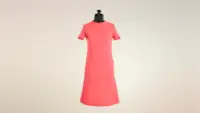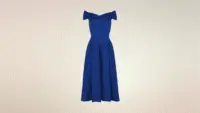Trumpet dress

When and where was this item first created, and what practical purpose did it serve?
The trumpet dress emerged in 1947 from Christian Dior’s revolutionary New Look collection in Paris. Dior created this silhouette as a direct response to the fabric rationing and masculine styling that dominated women’s fashion during World War II. The dress served a powerful psychological purpose beyond mere aesthetics.
It represented a return to feminine luxury and European haute couture dominance after years of American sportswear practicality. Dior specifically designed the trumpet shape to celebrate the female form through dramatic contrast. The fitted bodice emphasized the natural waist while the flared skirt created an hourglass silhouette that required substantial fabric yardage.
This extravagant use of material made a bold political statement about postwar prosperity and optimism. The name itself referenced the musical instrument’s flared bell shape. French textile manufacturers had lobbied fashion houses to create designs requiring more fabric to revive their struggling industry.
The trumpet dress perfectly served this economic need while establishing Dior as the arbiter of postwar feminine style. Its debut marked the end of wartime austerity dressing and launched the most influential fashion movement of the twentieth century.
It represented a return to feminine luxury and European haute couture dominance after years of American sportswear practicality. Dior specifically designed the trumpet shape to celebrate the female form through dramatic contrast. The fitted bodice emphasized the natural waist while the flared skirt created an hourglass silhouette that required substantial fabric yardage.
This extravagant use of material made a bold political statement about postwar prosperity and optimism. The name itself referenced the musical instrument’s flared bell shape. French textile manufacturers had lobbied fashion houses to create designs requiring more fabric to revive their struggling industry.
The trumpet dress perfectly served this economic need while establishing Dior as the arbiter of postwar feminine style. Its debut marked the end of wartime austerity dressing and launched the most influential fashion movement of the twentieth century.
What are the key design features and construction methods of this item?
The trumpet dress features a precisely fitted bodice that follows the natural torso line through the ribcage and waist. The skirt begins its dramatic flare at the hip line, creating a smooth transition from fitted to full. Construction requires expert pattern making to achieve the seamless flow between tight and loose sections.
The bodice typically incorporates princess seaming or strategically placed darts to mold the fabric to the body. Interior boning or structured interfacing maintains the smooth silhouette. French couturiers used a technique called draping on the stand to perfect the trumpet flare.
The skirt requires careful calculation of fabric distribution to achieve the proper bell shape without unwanted pulling or distortion. Traditional construction methods include hand-sewn French seams and couture finishing techniques. The hemline maintains consistent distance from the floor despite the flared shape through mathematical pattern adjustments.
Interior construction often features multiple layers including lining, interlining, and sometimes crinoline support. The waistline sits at the natural waist, requiring precise measurements for proper fit. Sleeves, when present, follow the same fitted principle as the bodice.
The bodice typically incorporates princess seaming or strategically placed darts to mold the fabric to the body. Interior boning or structured interfacing maintains the smooth silhouette. French couturiers used a technique called draping on the stand to perfect the trumpet flare.
The skirt requires careful calculation of fabric distribution to achieve the proper bell shape without unwanted pulling or distortion. Traditional construction methods include hand-sewn French seams and couture finishing techniques. The hemline maintains consistent distance from the floor despite the flared shape through mathematical pattern adjustments.
Interior construction often features multiple layers including lining, interlining, and sometimes crinoline support. The waistline sits at the natural waist, requiring precise measurements for proper fit. Sleeves, when present, follow the same fitted principle as the bodice.
What cultural movements and social contexts featured this item?
The trumpet dress became the defining garment of postwar femininity and European fashion recovery. It directly challenged American sportswear dominance that had emerged during wartime when European fashion houses were disrupted. The silhouette represented a rejection of masculine utility dressing that characterized the 1940s.
French fashion magazines promoted the trumpet dress as essential for the sophisticated modern woman. Department stores worldwide rushed to create affordable versions for middle-class consumers. The dress became associated with prosperity and leisure, requiring substantial fabric at a time when materials were expensive.
Hollywood costume designers embraced the silhouette for glamorous leading ladies, cementing its connection to luxury and romance. The trumpet dress played a crucial role in establishing Paris as the undisputed fashion capital after New York had gained prominence during the war. It represented European cultural recovery and artistic leadership.
Society photographers captured prominent women in trumpet silhouettes at charity galas, opera openings, and diplomatic functions. The dress required specific undergarments and accessories, driving entire supporting industries. Its popularity sparked debates about practicality versus beauty in women’s dress, with feminists criticizing its restrictive nature while others celebrated its feminine expression.
French fashion magazines promoted the trumpet dress as essential for the sophisticated modern woman. Department stores worldwide rushed to create affordable versions for middle-class consumers. The dress became associated with prosperity and leisure, requiring substantial fabric at a time when materials were expensive.
Hollywood costume designers embraced the silhouette for glamorous leading ladies, cementing its connection to luxury and romance. The trumpet dress played a crucial role in establishing Paris as the undisputed fashion capital after New York had gained prominence during the war. It represented European cultural recovery and artistic leadership.
Society photographers captured prominent women in trumpet silhouettes at charity galas, opera openings, and diplomatic functions. The dress required specific undergarments and accessories, driving entire supporting industries. Its popularity sparked debates about practicality versus beauty in women’s dress, with feminists criticizing its restrictive nature while others celebrated its feminine expression.
Is this item still produced today, and how has it evolved over time?
Contemporary designers continue producing trumpet dresses with modern adaptations for today’s lifestyle demands. The silhouette appears regularly in bridal collections, evening wear lines, and red carpet fashion. Modern versions often incorporate stretch fabrics that were unavailable in the 1950s, making the fitted portions more comfortable and practical.
Contemporary trumpet dresses may feature alternative closure systems like invisible zippers instead of complex hook and eye arrangements. Designers experiment with different flare points, sometimes beginning the trumpet shape at the knee rather than the hip. Current interpretations frequently use lighter weight fabrics that create the silhouette without requiring extensive internal structure.
Fast fashion retailers offer affordable versions that approximate the trumpet shape through strategic seaming and synthetic materials. High-end designers like Zac Posen and Christian Siriano have created notable modern trumpet dresses for celebrity clients. The silhouette remains popular for formal occasions where dramatic impact is desired.
Bridal designers particularly favor the trumpet shape for its combination of fitted elegance and romantic volume. Contemporary construction often combines traditional draping techniques with modern manufacturing methods. Pattern companies sell home sewing versions adapted for intermediate skill levels with simplified construction methods.
Contemporary trumpet dresses may feature alternative closure systems like invisible zippers instead of complex hook and eye arrangements. Designers experiment with different flare points, sometimes beginning the trumpet shape at the knee rather than the hip. Current interpretations frequently use lighter weight fabrics that create the silhouette without requiring extensive internal structure.
Fast fashion retailers offer affordable versions that approximate the trumpet shape through strategic seaming and synthetic materials. High-end designers like Zac Posen and Christian Siriano have created notable modern trumpet dresses for celebrity clients. The silhouette remains popular for formal occasions where dramatic impact is desired.
Bridal designers particularly favor the trumpet shape for its combination of fitted elegance and romantic volume. Contemporary construction often combines traditional draping techniques with modern manufacturing methods. Pattern companies sell home sewing versions adapted for intermediate skill levels with simplified construction methods.
How do you identify authentic vintage versions of this item?
Authentic 1950s trumpet dresses feature specific fabrics including heavyweight silk taffeta, duchess satin, or wool crepe that maintain structure without modern stretch properties. Original construction shows hand-finished French seams, couture-quality pressing techniques, and interior construction using silk organza or horsehair canvas for support. Period pieces display characteristic aging patterns where fitted areas show stress lines at armholes and waistline seams.
Authentic examples use metal zippers from manufacturers like Talon or Conmar, positioned in side seams rather than center back. Original labels include haute couture houses like Dior, Balenciaga, or licensed American manufacturers such as Christian Dior New York or Ceil Chapman. Period construction features hand-sewn buttonholes, covered buttons, and internal weights at hemlines to maintain proper draping.
Authentic pieces show specific proportional relationships with fitted bodices measuring precisely to natural waist placement and skirt fullness calculated mathematically for proper trumpet flare. Original examples often retain maker’s tags, alteration marks, or provenance documentation. Authentic 1950s examples exhibit particular wear patterns at pressure points and color fading consistent with vintage textile behavior.
Authentic examples use metal zippers from manufacturers like Talon or Conmar, positioned in side seams rather than center back. Original labels include haute couture houses like Dior, Balenciaga, or licensed American manufacturers such as Christian Dior New York or Ceil Chapman. Period construction features hand-sewn buttonholes, covered buttons, and internal weights at hemlines to maintain proper draping.
Authentic pieces show specific proportional relationships with fitted bodices measuring precisely to natural waist placement and skirt fullness calculated mathematically for proper trumpet flare. Original examples often retain maker’s tags, alteration marks, or provenance documentation. Authentic 1950s examples exhibit particular wear patterns at pressure points and color fading consistent with vintage textile behavior.


